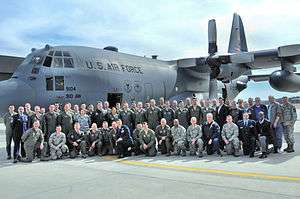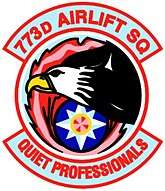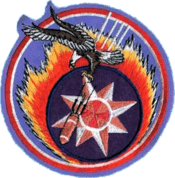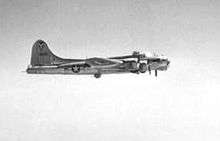773d Airlift Squadron
| 773d Airlift Squadron | |
|---|---|
 Past and present members of the 773d Airlift Squadron pose in front of a C-130 Hercules aircraft here, 6 April 2014 following the unit’s inactivation ceremony. | |
| Active | 1943-1945; 1953-1971; 1972-1993; 1994-2014 |
| Country |
|
| Branch |
|
| Role | Airlift |
| Part of | Air Force Reserve Command |
| Nickname(s) | Fleagles |
| Motto(s) | Quiet Professionals |
| Engagements |
|
| Decorations |
|
| Insignia | |
| 773d Airlift Squadron (approved 23 December 1957[1] |
 |
| 773d Bombardment Squadron emblem[2] |
 |
The 773d Airlift Squadron historically calls itself the "Fleagles" and was assigned to the 910th Airlift Wing (Air Force Reserve Command), Youngstown Air Reserve Station, Ohio. The unit flew the C-130 H2.5 aircraft.
During World War II, the 773d Bombardment Squadron was a B-17 Flying Fortress squadron, assigned to the 463d Bombardment Group, Fifteenth Air Force. It earned Two Distinguished Unit Citations. The unit later served as a C-130 Hercules tactical airlift squadron during the Vietnam War.
Mission
On 1 April 1995, with the Reserve Forces building, the Department of Defense reactivated the 773d at the Youngstown-Warren Regional Airport, joining the 910th Airlift Wing and the 757th Airlift Squadron. Since that time the 773d has flown numerous humanitarian missions from Europe to the former Yugoslavia. Delivering peacekeeping forces, food, and medicines to aid the people of the region. The 773d also continues the rotational airlift requirement for Central and South America, Southeast Asia and the Far East.
History
Established in mid-1943 as a B-17 Flying Fortress heavy bombardment squadron; assigned to Second Air Force for training. Attached in late 1943 and early 1944 to Air University Army Air Force School of Applied Tactics. Deployed to Mediterranean Theater of Operations (MTO) in February 1944, squadron taking the South Atlantic Transport Route though the Caribbean and South America; transiting the Atlantic Ocean via Brazil and Dakar, French West Africa, being assigned to Fifteenth Air Force in March 1944 at several airfields in Southern Italy.

Engaged in long-range strategic bombardment of enemy military, industrial and transport targets, including oil refineries and production oilfields in Italy; France; Southern Germany; Austria and the Balkans. Continued strategic bombardment until German capitulation in May 1945. Demobilized in place in Italy during the summer of 1945; inactivated in September 1945.
Reactivated as a Tactical Air Command Troop Carrier squadron in June 1953, assigned C-119 Flying Boxcars. Engaged in transport of equipment and supplies; including support of Army Airborne parachute units throughout the 1950s and early 1960s. Equipped with new C-130A Hercules in 1956.
Deployed to Pacific Air Forces in 1966, being stationed in the Philippines. Engaged in airlift missions between the Philippines and South Vietnam, airlifting supplies and equipment to airfields in the combat areas; evacuating wounded personnel to hospitals at Clark Air Base. Remained in the Western Pacific until 1971 when inactivated as part of the drawdown of United States forces in the region.
Reactivated at Dyess AFB, Texas as a theater airlift squadron in June 1972, initially under Tactical Air Command, later Military Airlift Command and lastly Air Mobility Command. Deployed frequently to Europe or the Pacific, performing intra-theater airlift missions with C-130s. Inactivated in October 1993 as part of the drawdown of the USAF after the end of the Cold War.
Reactivated in 1995 in the Air Force Reserve. Nicknamed "The Quiet Professionals", members of the 773rd have deployed worldwide supporting contingency and humanitarian operations. Since 2001, members of the squadron have mobilized numerous times in support of the Global War on Terrorism. The Citizen Airmen operated out of bases in Southwest Asia including isolated airfields in Iraq and Afghanistan to provide airlift and airdrop capability of equipment and personnel.
Inactivated on 6 April 2014.
Lineage
- Constituted 773d Bombardment Squadron (Heavy) on 19 May 1943
- Activated on 1 August 1943
- Redesignated 773d Bombardment Squadron, Heavy c. 29 September 1944
- Inactivated on 25 September 1945
- Redesignated 773d Troop Carrier Squadron, Medium on 1 December 1952
- Activated on 16 January 1953
- Redesignated: 773d Troop Carrier Squadron, Assault on 18 December 1961
- Redesignated: 773d Troop Carrier Squadron, Medium on 15 May 1965
- Redesignated: 773d Troop Carrier Squadron on 1 January 1967
- Redesignated: 773d Tactical Airlift Squadron on 1 August 1967
- Inactivated on 15 June 1971
- Activated on 1 June 1972
- Redesignated 773d Airlift Squadron on 1 November 1991
- Inactivated on 1 October 1993
- Activated in the reserve on 1 April 1995[1]
- Inactivated on 6 April 2014
Assignments
- 463d Bombardment Group, 1 August 1943 – 25 September 1945
- 463d Troop Carrier Group, 16 January 1953
- 463d Troop Carrier Wing, 25 September 1957
- 840th Air Division, 23 November 1965
- 463d Troop Carrier Wing (later 463d Tactical Airlift Wing), 7 February 1966 – 15 June 1971
- 463d Tactical Airlift Wing, 1 June 1972
- Attached to 513th Tactical Airlift Wing, 1 June – 14 July 1972; 28 August – 16 November 1972; 5 July – 5 September 1973; 5 May – 15 July 1974; 5 May – 14 July 1975; 374th Tactical Airlift Wing, 28 February-c. 10 May 1973
- 463d Operations Group, 1 November 1991 – 1 October 1993[1]
- 910th Operations Group, 1 April 1995 - 6 April 2014
Stations
|
|
Aircraft
- B-17 Flying Fortress, 1943–1945
- C-119 Flying Boxcar, 1953–1957
- C-130 Hercules, 1956–1971; 1972–1993; 1995–2014[1]
See also
References
Notes
Bibliography
![]()
- Maurer, Maurer, ed. (1983) [1961]. Air Force Combat Units of World War II (PDF) (reprint ed.). Washington, DC: Office of Air Force History. ISBN 0-912799-02-1. LCCN 61060979. Retrieved December 17, 2016.
- Maurer, Maurer, ed. (1982) [1969]. Combat Squadrons of the Air Force, World War II (PDF) (reprint ed.). Washington, DC: Office of Air Force History. ISBN 0-405-12194-6. LCCN 70605402. OCLC 72556. Retrieved December 17, 2016.
- Ravenstein, Charles A. (1984). Air Force Combat Wings, Lineage & Honors Histories 1947-1977 (PDF). Washington, DC: Office of Air Force History. ISBN 0-912799-12-9. Retrieved December 17, 2016.
- Watkins, Robert A. (2009). Insignia and Aircraft Markings of the U.S. Army Air Force In World War II. Volume IV, European-African-Middle Eastern Theater of Operations. Atglen,PA: Shiffer Publishing, Ltd. ISBN 978-0-7643-3401-6.
External links
- "C-130 Dyess timeline". Abeline Reporter News. April 23, 2011. Archived from the original on August 12, 2011. Retrieved January 29, 2014.
- 910 Operations Group Factsheet
